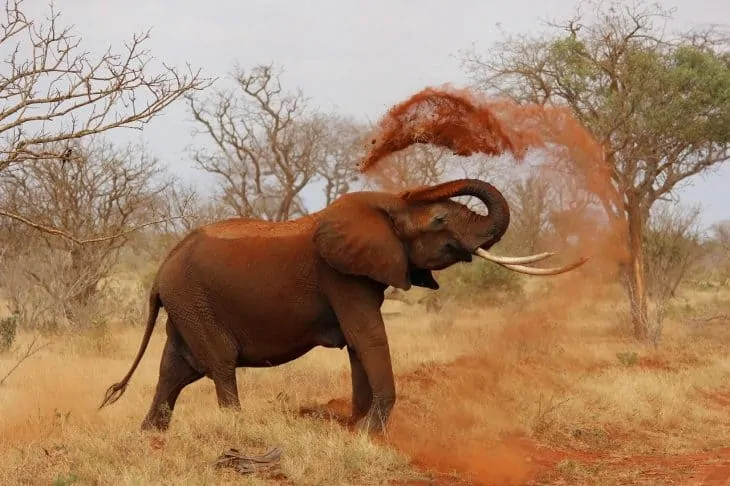
With their long trunks and hulking size, elephants tower over the savannas as the largest land animal in the world. However, there’s more to this creature than their size or unique looks. As one of the most sensitive animals, numerous studies have revealed elephants’ high intelligence and empathy. This makes it even more unfortunate that their numbers are quickly dwindling. Take a closer look at nature’s biggest softies with these elephant facts.
- Elephants are the largest land animals.
- There are 3 surviving species of elephants: Asian elephant, African bush elephant, and the African forest elephant.
- Depending on its species, elephants typically live for 48 to 80 years.
- Elephants weigh from 2,700 kg to 6,000 kg.
- Today, only 400,000 elephants roam the wild.
- Elephants first evolved 80 million years ago.
- However, the first creature to have elephant-like features only appeared 35 million years ago.
- Loxodonta is the scientific name of the elephant.
- Mammoths are the extinct species of the elephantoid genus Mammuthus.
- All elephants are herbivores.
- ‘Asiatic elephant’ is the other name of the Asian elephant (Elephas Maximus).
- African savanna elephant’ is the other name of the African bush elephant (Loxodonta Africans).
- Elephant trunks have 8 major muscles along each side, with 150,000 muscle bundles in total.
- In the last hundred years, around 10 million elephants still roamed the wild.
- The IUCN classifies elephants as Endangered.
- The elephant’s trunk is also called a proboscis.
- Elephant trunks are so powerful that they can push down trees or lift up to 700,000 pounds.
- Elephant skin is thick but highly sensitive.
- The largest elephant ever recorded stood at a 13 ft shoulder height and weighed 11,000 kg.
- The oldest elephant in history died at 86 years old.
Elephant Facts Infographics
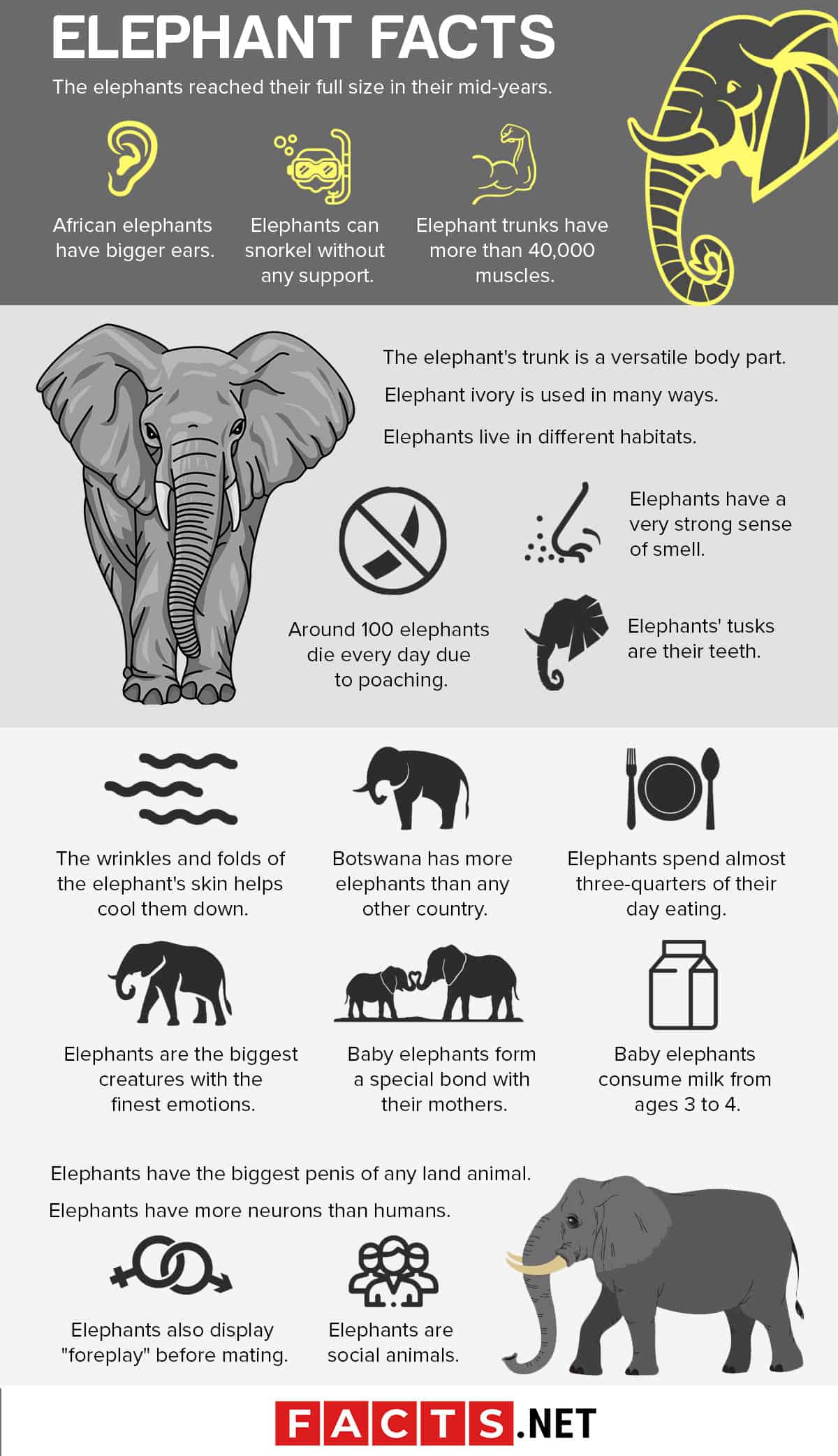
The elephants reached their full size in their mid-years.
Male elephants reach their full size at the age of 25 to 40, weighing up to 12,000 pounds. Meanwhile, female elephants, reach their full size at the age of 15 to 30 weighing an average of 8,000 pounds. The average life span of a male is 60 to 70 years, while the female 50 to 60 years.
African elephants have bigger ears.
Aside from being significantly larger than other species, the African elephant’s distinguishing feature is its bigger ears which resemble the African continent.
The African elephants’ trunks have two “fingers” at the tip which they use to grab objects.
Elephants can snorkel without any support.
Elephants are the only animals that can snorkel without any aid in the animal kingdom. They can walk to the bottom of a river or cross them entirely submerged by keeping their trunks above the water.
Elephant trunks have more than 40,000 muscles.
Elephant trunks have 40,000 muscles with 150,000 individual parts. In comparison, the average human body only has 639 muscles.
The elephant's trunk is a versatile body part.
The elephant’s trunk carries most of its sensory organs. Structurally, the trunk serves as the upper lip and nose of the elephants. They use it for smelling, breathing, touching, holding, and producing sound.

Around 100 elephants die every day due to poaching.
On average, around 100 African elephants die every day due to illegal hunting. Each day, poachers kill elephants for their ivory, meat, and other body parts. If this unlawful practice continues, elephants could soon go extinct.
Elephant ivory is used in many ways.
Ivory refers to the solid white material from the elephant’s tusks. Its ivory bears criss-crossed lines that form a series of diamond shapes when viewed in cross-sections.
Commercially, elephant ivory is used for manufacturing billiard balls, piano keys, organ keys, decoration, jewelry, as well as electrical equipment for airplanes and radar.
Elephants have a very strong sense of smell.
Elephant trunks are four times as sensitive as a bloodhound’s scent. According to reports, elephants can even smell water from miles away. The elephant has a heightened sense of smell due to millions of receptor cells in its upper nasal cavity.
Elephants live in different habitats.
Elephants are commonly found throughout Southeast Asia, South Asia, and sub-Saharan Africa. They live in different habitats such as forests, savannahs, deserts, and marshes.
Elephants' tusks are their teeth.
Although they may look like horns, elephant tusks are actually large incisors, similar to canines in human teeth. Tusks usually appear once an elephant reaches 2 years of age. These tusks continue to grow throughout their life span.
Elephants use their tusks for lifting, digging, collecting food, and prying bark from trees to eat. Their tusks also function as their primary defense once threatened.
The wrinkles and folds of the elephant's skin helps cool them down.
Compared to the flat skin of humans, the wrinkles and folds in elephant skin can hold up to 10 times more moisture. Elephants keep their skin healthy and protect themselves from sunburn by rolling in mud and taking regular dust baths.
Botswana has more elephants than any other country.
The arid expanse of savannas in Botswana holds more elephants than any other country in the world. Furthermore, Southern Africa as a whole houses more than 290,000 elephants, which is 70% of the remaining African elephant population.
Elephants spend almost three-quarters of their day eating.
To support their large frame, elephants need to consume up to 160kg of vegetation daily. Typically, elephants spend about sixteen to eighteen hours of their day feeding. The elephant diet consists mostly of tree bark, fruits, twigs, grasses, bushes, small plants, and roots.
Elephants are social animals.
Elephants would spend most of their time communicating with other members of their her. As highly intelligent animals, elephants can develop a clear social structure within their herds of 8-100 individuals.

Elephants have more neurons than humans.
The elephant has the biggest brain of any land animal. Above all, it has thrice as many neurons as humans. These cells within the nervous system transmit information to other nerve cells, which explains why elephants have more heightened senses than humans.
Elephants are the biggest creatures with the finest emotions.
Elephants are expressive creatures that experience joy, love, compassion, grief, and anger. According to scientists, elephants are capable of complex thoughts with deep feelings.
Baby elephants form a special bond with their mothers.
Unlike other animals, elephants are very protective of their young. Mother elephants usually wrap their trunks over the baby elephant while emitting a gentle rumbling sound. These public displays are as protective as they are affectionate.
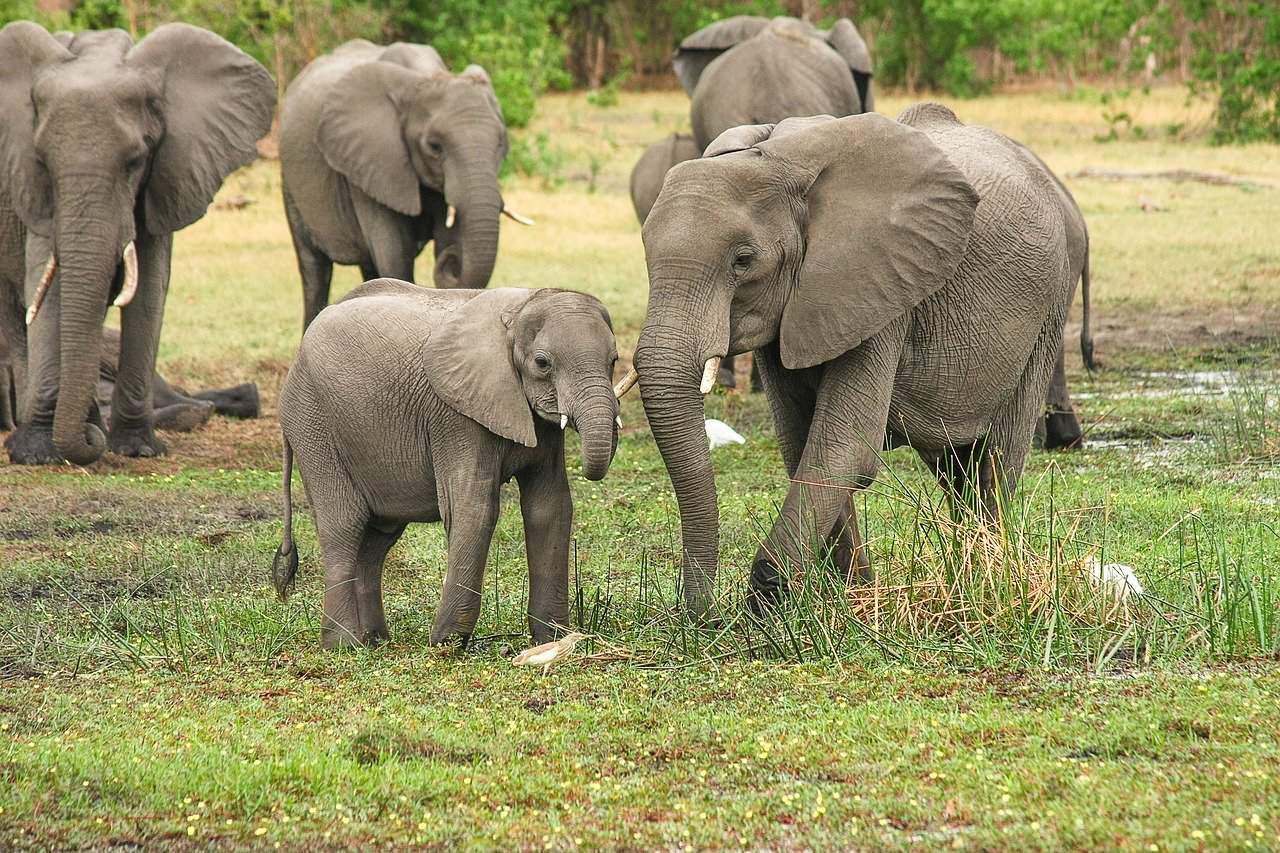
Baby elephants consume milk from ages 3 to 4.
From its birth until a few years of age, elephant calves normally depend on their mother’s milk as their primary sustenance. Although calves may start eating plants as early as 2 years old, they still consume milk from ages 3 to 4.
By the time a calf is 9 months old, 40% of its diet consists of vegetation with the remainder being for their mother’s milk.
Elephants also display "foreplay" before mating.
While mating, elephants often stroke one another with their trunks before the male mounts the female from behind. After this display, the male will stand almost vertically as they mate. Elephant mating lasts around two minutes on average.
Elephants have the biggest penis of any land animal.
As the largest land animals, elephants also tower over the rest of the animal kingdom in terms of their genitalia. An elephant’s penis measure 6 inches in diameter, with the average length of 39 inches. How’s that for neat elephant facts?
Female elephant groups are led by a matriarch elephant.
Male elephants usually leave the family clan within the ages of 12 to 15. These males either live in solitary or live temporarily with other male elephants. Thus, female elephants tend to live in groups.
These females are usually related and headed by a matriarch which is usually the oldest in the clan. This leader determines when and where they rest and move.
Elephants can run faster than a human.
Elephants can run approximately 35 to 40 kilometers per hour. Meanwhile, the Olympic gold medalist, and currently the fastest man in the world, Usain Bolt recorded his top speed at 37.383 kilometers per hour. Definitely one of the elephant facts to take note of.
Tusks can indicate an elephant's age.
Since elephant tusks never stop growing, longer tusks mean that the elephant is older. Both male and female African elephants have tusks. However, this differs in Asian elephants. With Asian elephants, only some males have tusks, with females typically having shorter ones.
African Forest elephants are not a subspecies of African elephants.
According an old study, African Forest elephants descended from African elephants. However, recent research shows that they are entirely separate species. The African Forest elephants live in the tropical forest of West Africa and the Congo Basin. Compared to the Savannah elephants – a subspecies of African elephants -African Forest elephants have more rounded ears and straighter tusks.
Elephants become sexually mature by the age of 17.
The adolescent stage of elephants occurs between 10 to 17 years of age. By the time they reach 17 years old, elephants reach sexual maturity, which is also around the time when most elephants experience ‘musth’ or increased testosterone and aggression levels.
Musth is a common problem for elephants.
When elephants experience musth, its testosterone levels can be up to 60 times greater than an average elephant’s testosterone. According to research, musth is problematic since even the calmest elephants can become highly violent to other elephants and humans during this period.
Elephants can produce a tonne of poop in a week.
One of the elephant facts only fitting for the largest land animals: A single elephant can produce about a ton of poo in one week. Consequently, their massive excretion contributes to the environment as it keeps the soil fertile and scatters tree seeds.
Elephants use infrasound and seismic communication.
Aside from the five main senses, elephants communicate using infrasound, or low-frequency noise unheard by the human ear. Similarly, elephants can also pick up and emit vibrations over long distances with seismic communication.
Elephants have a huge impact on their surroundings.
Because of their massive size, elephants can drastically change the landscape around them. Their habit of uprooting trees for their food, digging waterholes, and creating footpaths can change savannas into grassland.
During periods of drought, elephants also tend to dig and create waterholes that can benefit other animals as well. Definitely one of the elephant facts that prove their role in ecology.
Elephant skeletons have 326 to 351 bones.
The elephant’s skeleton is composed of up to 351 bones. Typically, the Asian elephant has 20 pairs of ribs, while the African elephant has 21 pairs of ribs. The elephant’s vertebrae are connected by tight joints, which limit the backbone’s flexibility.
Elephants often seek mineral salts as their supplement.
A group of elephants in Mount Elgon National Park in Kenya have been observed mining for salt in the underground caves with their tusks. This mineral salt is essential to the elephant’s health. They search for this mineral whenever they cannot get sufficient sodium from their food like woody plants.
The elephant skull is highly shock-absorbent.
The rear of the elephant’s skull forms curves as it is flat and spread out. This structure protects the brain from all angles. Thus, the elephant skull is flexible enough to endure the weight produced by the leverage of tusks as well as head-to-head clashes.
The elephant's skull has air cavities.
The elephant’s skull has air cavities or sinuses that decrease the weight of their skull while preserving overall strength. The cavities inside the elephant’s skull have a “honeycomb-like” appearance.
The head of an African elephant weighs more than 800 lbs.
The skull and jaw of an African elephant weigh approximately 180kg or 400 lbs. Its trunk weighs about 245 lbs while the tongue is 30 lbs. An elephant’s brain can reach 15 lbs in weight. In total, an African elephant’s head weighs roughly 880 lbs along with its tusks.
Elephants do not have good eyesight.
Elephants may have evolved with heightened senses, but this is not the case for their eyes. Elephant eyes are small due to its positioning, measuring a mere 1.5 inches in diameter. Their poor eyesight only ranges 25 feet, along with a limited peripheral vision.
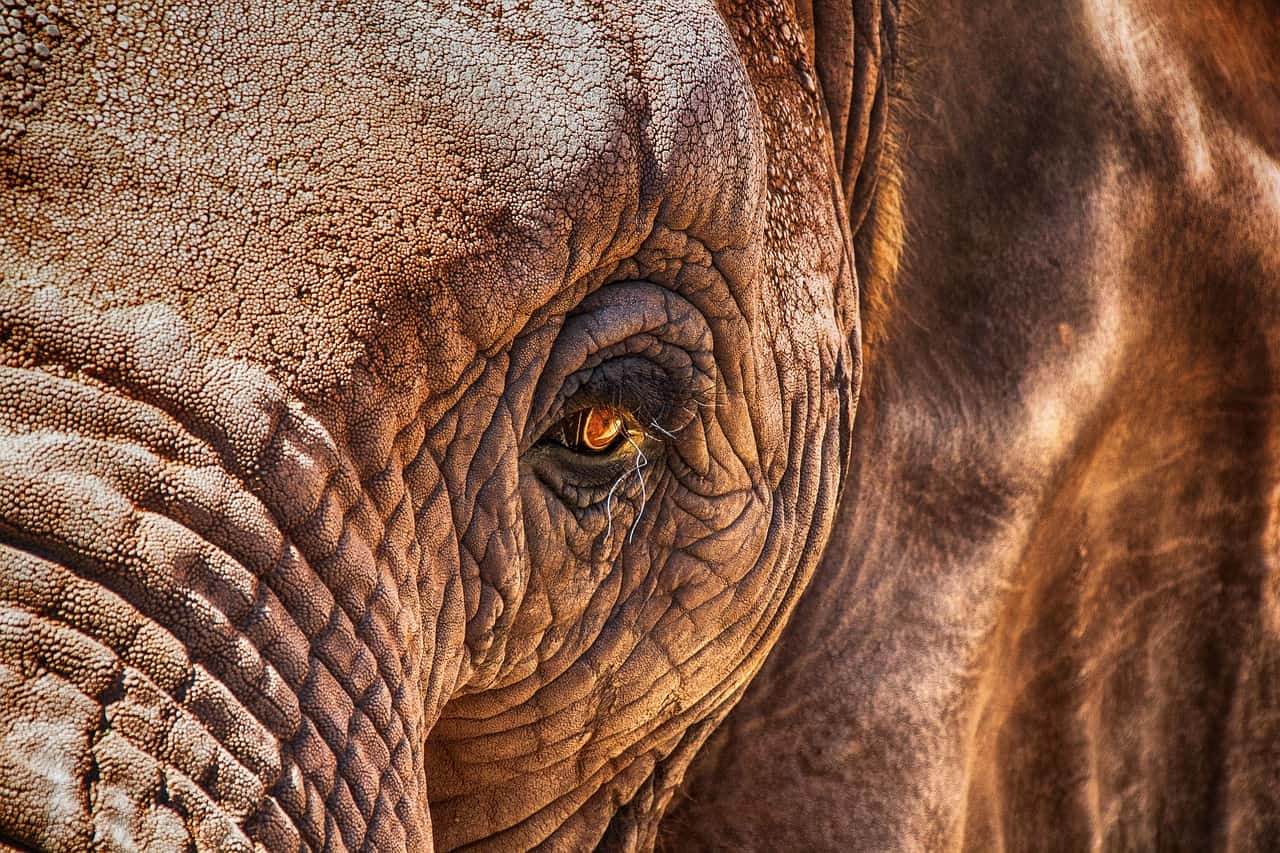
Elephant uses its ears to release excess body heat.
Elephant ears have thin tips and thick bases. Several blood vessels called capillaries line the outer part of their ears. The elephant’s warm blood circulates into these capillaries that help release excess body heat.
The elephant's limbs are positioned more vertically under the body.
Compared to most mammals, elephants carry their weight well since their limbs are positioned more vertically under their bodies. Elephants’ limbs are equipped with a specialized cancellous bone in place of medullary cavities. This structure strengthens the elephant’s bones while enabling ‘hematopoiesis‘ or the formation of blood cellular components.
An elephant's gestation takes almost two years.
Gestation refers to the period of development between carrying an embryo or fetus until birth. Elephant pregnancy generally takes 640 to 660 days, with interbirth intervals that last up to 4 or 5 years.
Elephants have the longest pregnancy of all mammals.
Comparing the elephant’s gestation (roughly 95 weeks) to human pregnancy (9 months or 40 weeks), elephant pregnancy lasts over twice as long. In fact, elephants have the longest gestation period of all mammals. Even a blue whale‘s gestation period lasts only 10 to 12 months.
There is a 1% to 2% chance that an elephant can produce twins.
Typically, elephants only carry one baby at a time. However, there is around 1% to 2% chance that an elephant may carry twins. Once they give birth, elephants herds form a protective circle around the mother during the delivery.
The most famous elephant twins are named "Emma and Elon Tusk."
In 2018, twin elephants were born in the wild from a herd of African elephanta. The calves were aptly named “Emma” and “Elon Tusk.” Their mother, Eloise, was 5 years old when she gave birth to the twins.
Twin elephants have a high mortality rate.
Given the slim odds of bearing twins, twin elephants have a higher mortality rate, since mother elephants only have enough milk for one offspring. In the case of Emma and Elon Tusk, researchers for Wildlife Conservation Society (WCS) took them in to monitor their development.
Elon Musk once changed his name on Twitter to "Elon Tusk."
In 2019, Elon Musk (CEO of Tesla and SpaceX) changed his name on Twitter to “Elon Tusk” with an elephant emoji. According to the CEO, he was just messing around. However, he may have indirectly referenced the twin elephants, “Emma and Elon Tusk.” Talk about coincidence.
A newborn elephant already weighs more than 250 lbs.
Mother elephants may be extremely loving, but they won’t be carrying their young anytime soon. A newborn elephant or calve stands at an average of 2 feet and 7 inches. Furthermore, its already weights 250 lbs or 113 kilograms at birth. Definitely one of the elephant facts that are hard to imagine.
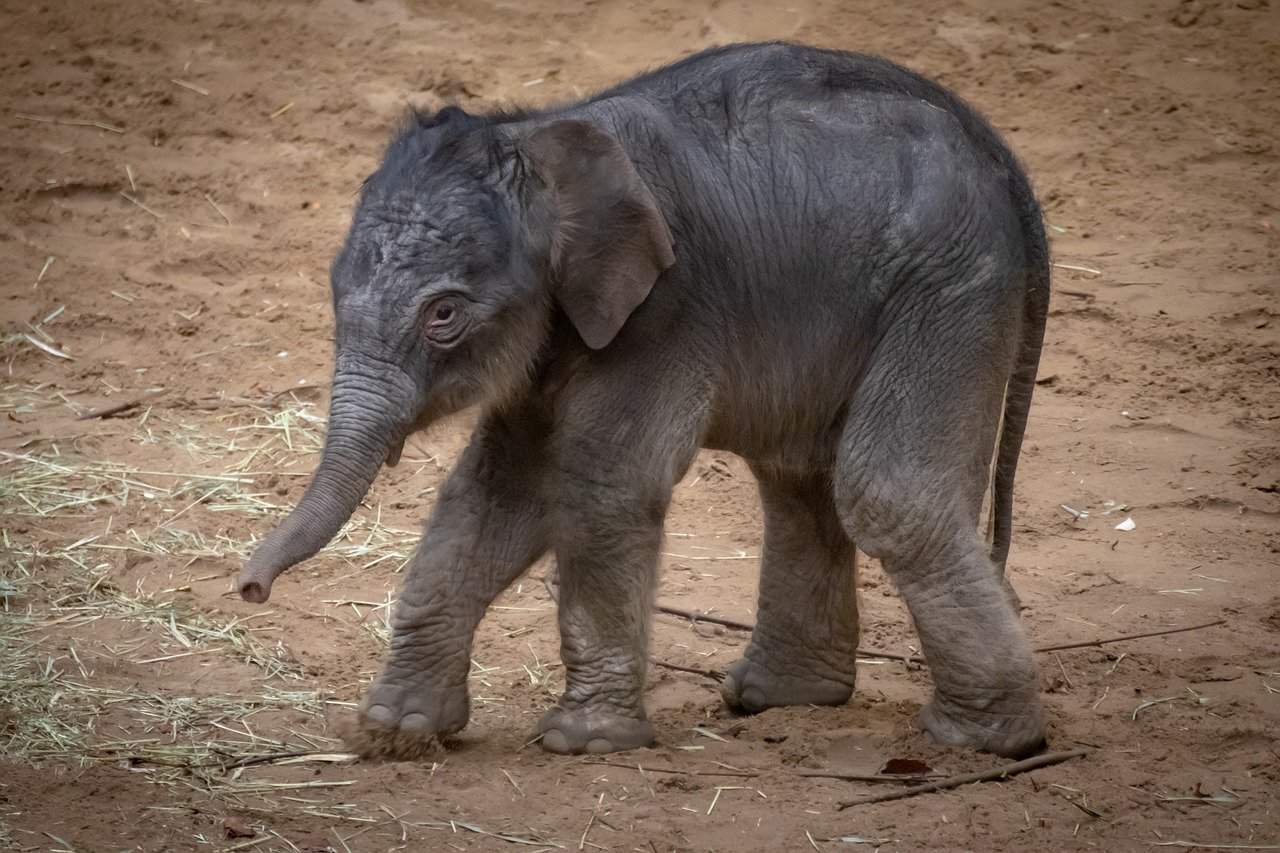
Newborn elephants can immediately walk.
Unlike some animals that are born helpless, newborn elephants are relatively mature and mobile from the moment of birth. In other words, they can instantly stand or walk to join their mother and family herd. A new baby elephant usually becomes the center of attention in the family or herd.
A calf normally gets used to its trunk after a year.
Although newborns can be mobile, it’s still unsteady on its feet for first few days, still needing support from its mother. In its second week, the calf can walk more steadily and will start to learn how to control its trunk properly.
Furthermore, within just one month, a calf can pick up, hold, and put things in its mouth using its trunk. However, they still can’t suck water through its trunk. Instead, they drink directly through their mouths, taking up to a year before fully using its trunk.
Elephants can regrow their teeth.
Elephants normally have 26 teeth including the tusks which are the incisors, 12 molars, and 12 milk teeth. Most mammals are diphyodonts with two sets of teeth, much like humans’ milk teeth and permanent ones.
However, as polyphyodonts, elephants can regrow all their teeth throughout their lives except for their tusks.
Elephants have a cycle of teeth rotation.
Elephant teeth usually regrows up to six times in their lifetime. When elephants reach 2 to 3 years of age, their first set of molars falls out. The second cycle comes at the age of 4 to 6. The third cycle is when the elephants are 9 to 15 years old, while the fourth set of teeth lasts up to 18 to 28 years old.
In the elephants’ early 40s, their fifth set of teeth typically falls out. Finally, their last set of teeth should last for the rest of the elephants’ life. How’s that for a mouthful of elephant facts?
Touching is an essential form of communication among elephants.
Elephants of different ages and gender greet each other by caressing or wrapping their trunks. When socializing, elephants normally touch their genitals, mouths, and temporal glands which are located between their eyes and ears.
Elephants have been used for labor since the 3300 BCE.
As early as the Indus Valley Civilization from 3300 BCE to 1300 BCE), elephants have been unfortunately exploited for labor. People used to capture elephants with ropes and traps before using tranquilizers in the 1950s.
Moreover, in the year 2000, over 13,000 elephants have been recorded working in captivity in Asia. These elephants generally came from the wild, captured between 10 to 20 years of age to be trained and used as tourist attractions.
Was this page helpful?
Our commitment to delivering trustworthy and engaging content is at the heart of what we do. Each fact on our site is contributed by real users like you, bringing a wealth of diverse insights and information. To ensure the highest standards of accuracy and reliability, our dedicated editors meticulously review each submission. This process guarantees that the facts we share are not only fascinating but also credible. Trust in our commitment to quality and authenticity as you explore and learn with us.
